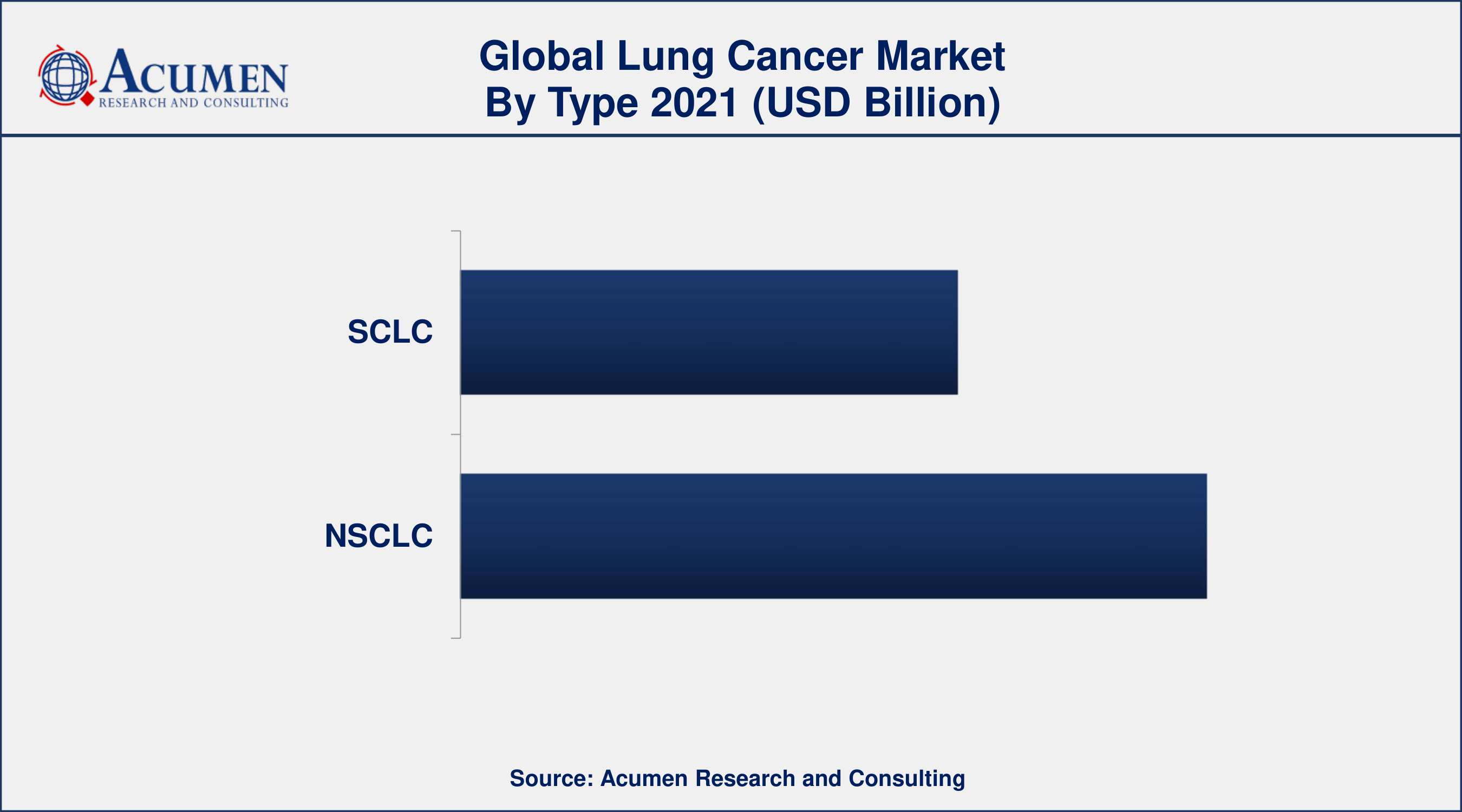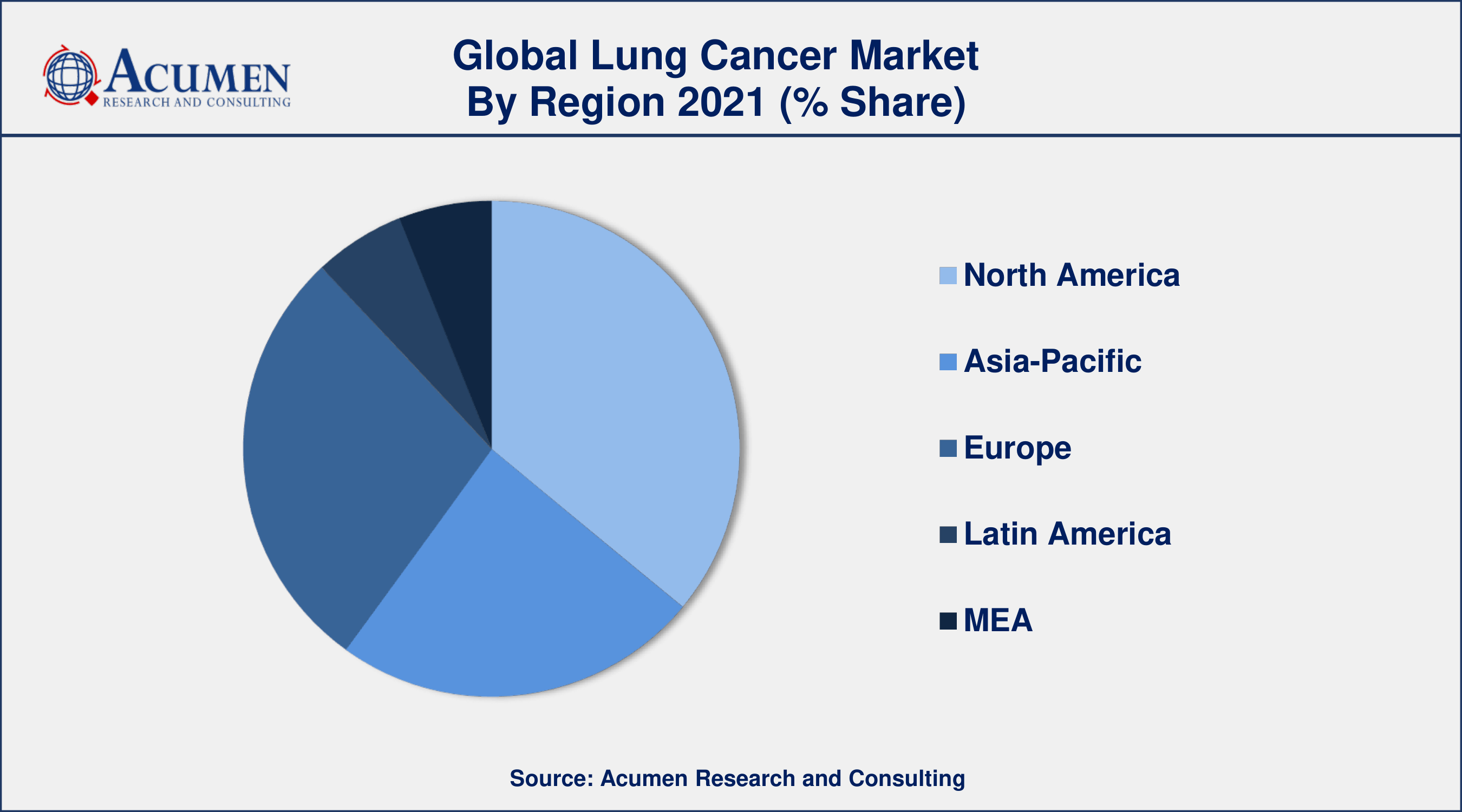Lung Cancer Market Size - Global Industry, Share, Analysis, Trends and Forecast 2022 - 2030
Published :
Report ID:
Pages :
Format :
Lung Cancer Market Size - Global Industry, Share, Analysis, Trends and Forecast 2022 - 2030
Report Coverage
- Industry Dynamics
- Market Size and Forecast Data
- Segment Analysis
- Competitive Landscape
- Regional Analysis with a Niche Focus on Country-Level Data
- High Level Analysis - Porter's, PESTEL, Value Chain, etc.
- Company Profiles of Key Players
- Option to Customize the Report As Per Your Specific Need
Request Sample Report
The Global Lung Cancer Market Size accounted for USD 21.1 Billion in 2021 and is estimated to achieve a market size of USD 67.9 Billion by 2030 growing at a CAGR of 14.1% from 2022 to 2030. The global lung cancer market growth is predicted to expand rapidly as the incidence of lung cancer rises. Furthermore, rising R&D and product approvals will contribute to the expansion of the lung cancer market value throughout the forecast period.

Lung Cancer Market Report Key Highlights
- Global lung cancer market revenue is expected to increase by USD 67.9 billion by 2030, with a 14.1% CAGR from 2022 to 2030
- North America region dominates with more than 35.5% lung cancer market share in 2021
- According to the American Cancer Society, approximately 236,740 new instances of lung cancer in the US in 2022, with 117,910 in men & 118,830 in women
- By type, the NSCLC segment has accounted market share of over 60% in 2021
- By end-user, hospital and clinics sector engaged more than 45% of the total market share in 2021
- Asia-Pacific regional market is predicted to grow at a remarkable CAGR over the forecast period
Lung cancer is cancer that starts in the lungs. Lung cancer is the leading cause of death from cancer worldwide. The majority of lung cancers do not cause symptoms until they have spread, but some people with early lung cancer do. According to the American Cancer Society, there will be approximately 235,760 new cases of lung cancer in 2021. (119,100 in men and 116,660 in women). In addition, approximately 131,880 lung cancer deaths have been recorded (69,410 in men and 62,470 in women). Lung cancer is by far the leading cause of cancer death in both men and women, accounting for nearly 25% of all cancer deaths. Lung cancer kills more people each year than colon, breast, and prostate cancer combined.
What Is New In The Lung Cancer Market?
As per the report released by the Lung Cancer Foundation of America., Biomarker testing is key in today’s world of personalized medicine. Lung cancer biomarker testing, also known as genetic mutation testing, or genomic testing, looks for the mutations, or “specific biomarkers” in the cells of a tumor. These biomarkers can be used to help a lung cancer patient decide on the best course of treatment. A new study has identified a potential biomarker of early-stage non–small cell lung cancer, according to a report released by the United States Department of Health and Human Services in January 2019. (NSCLC). A protein called "SGLT2" is used to transport glucose into some cells and is a potential new biomarker. The biomarker could help noninvasively diagnose precancerous lung growths (called nodules or lesions) and early-stage lung cancers, as well as distinguish them from noncancerous lung nodules (benign).
Global Lung Cancer Market Dynamics
Market Drivers
- Rise surge in lung cancer cases
- Growing demand for targeted therapies
- Increasing adoption of Immunotherapy
- Growing rates of early detection
Market Restraints
- High cost of treatment
- Scarcity of lung transplant organs
Market Opportunities
- Reimbursements and growing health insurance
- Technological advancement in healthcare facilities
Lung Cancer Market Report Coverage
| Market | Lung Cancer Market |
| Lung Cancer Market Size 2021 | USD 21.1 Billion |
| Lung Cancer Market Forecast 2030 | USD 67.9 Billion |
| Lung Cancer Market CAGR During 2022 - 2030 | 14.1% |
| Lung Cancer Market Analysis Period | 2018 - 2030 |
| Lung Cancer Market Base Year | 2021 |
| Lung Cancer Market Forecast Data | 2022 - 2030 |
| Segments Covered | By Type, By Treatment, By End-User, And By Geography |
| Regional Scope | North America, Europe, Asia Pacific, Latin America, and Middle East & Africa |
| Key Companies Profiled | AstraZeneca plc, Eli Lilly and Company, The Merck Group, Sanofi S.A., Pfizer Inc., GlaxoSmithKline, F. Hoffmann-La Roche AG, and Boehringer Ingelheim GmbH. |
| Report Coverage |
Market Trends, Drivers, Restraints, Competitive Analysis, Player Profiling, Covid-19 Analysis, Regulation Analysis |
Lung Cancer Therapeutics Market Dynamics
Targeted Therapies Have Gained Huge Significance In The Global Lung Cancer Treatment Market
Targeted treatments identify and attack specific types of cancer cells while causing less harm to healthy cells. Many targeted therapies for advanced lung cancer have become available in recent years, and more are in development. There are currently FDA-approved targeted therapies for lung cancer tumors with EGFR, ALK, ROS-1, NTRK, MET, RET, and BRAF V600E mutations. Additionally, it was not until the emergence of targeted therapy based on molecular typing that the survival period of patients with advanced NSCLC was improved to several years, such as the second generation ALK-TKI alectinib (Alecensa) achieved the PFS of first-line NSCLC patients with ALK fusion up to 34.8 months, and the adverse reactions were greatly reduced, such as the adverse events of grade 3 or higher was lower with the third generation EGFR-TKI osimertinib (Tagrisso, 23%) than with platinum-pemetrexed (47%).
Lung Cancer Market Drivers
Geriatric Population More Succumbed For Developing Lung Cancer
Concerns about treatment tolerability, toxicity, and limited clinical trial data in the elderly impede the treatment of elderly patients with lung cancer, potentially leading to treatment nihilism among clinicians. According to Cancer Facts and Figures, the leading causes of cancer death in the elderly are the same as those for all ages. Prostate and lung cancer are the leading causes of cancer death in men aged 85 and up, accounting for 40% of all cancer deaths. Lung cancer is the leading cause of cancer death among women (19%), followed by breast cancer (13%).
Rising Prevalence Of Smoking Among The Population Is More Prone To Develop Lung Cancer
In the United States, lung cancer is by far the leading cause of cancer death in both men and women. Smoking is also a major risk factor for lung cancer. According to data released by the Centers for Disease Control and Prevention, cigarette smoking is responsible for approximately 80% to 90% of lung cancers in the United States (CDC). Furthermore, in 2016, approximately 38 million adults smoked, and approximately 3 million high school and middle school students smoked in 2017. Despite the fact that the proportion of adult smokers is higher, the geographic patterns of cigarette use among adults and youth are similar. The states with the highest percentage of current adult smokers are concentrated in the Midwest, South, and Northeast.
Lung Cancer Market Segmentation
The global lung cancer market segmentation is based on type, treatment, end-user, and geography.
Lung Cancer Market By Type
- SCLC
- NSCLC

According to a lung cancer industry analysis, the NSCLC segment has dominated the global market by type in the past and is likely to do so again throughout the forecast timeframe. According to the American Cancer Society, Inc., NSCLC is more prevalent in the population, accounting for approximately 84% of all cases. This is one of the most important factors that have a positive impact on segmental growth, ultimately contributing to the growth of the global lung cancer market trend.
Lung Cancer Market By Treatment
- Surgery
- Chemotherapy
- Photodynamic Therapy (PDT)
- Radiotherapy
- Laser Therapy
In terms of treatment, the chemotherapy segment accounts for a considerable percentage of the worldwide market's growth. Adjuvant chemotherapy is the accepted standard of care for certain patients with early-stage non–small cell lung cancer, according to several randomized trials and meta-analyses (NSCLC). Adjuvant chemotherapy is appropriate for patients with stage II, IIIA, or large (4 cm) IB tumors. Adjuvant chemotherapy improves survival by about 5% after 5 years, though some trials have suggested that it can be as high as 8% to 10%. Although the volume of data with this approach is far less than that with adjuvant chemotherapy, neoadjuvant chemotherapy has also shown a survival advantage.
Lung Cancer Market By End-User
- Hospitals & Clinics
- Cancer Research Centers
- Laboratories
According to the lung cancer market forecast, the hospital and clinics segment is expected to be the fastest-growing category throughout the projected period. The rising number of cancer patients admitted to hospitals for treatment and diagnosis has greatly raised lung cancer sales from hospitals and clinics around the world.
Lung Cancer Market Regional Outlook
North America
- U.S.
- Canada
Europe
- U.K.
- Germany
- France
- Spain
- Rest of Europe
Asia-Pacific
- India
- Japan
- China
- Australia
- South Korea
- Rest of Asia-Pacific
Latin America
- Brazil
- Mexico
- Rest of Latin America
The Middle East & Africa
- South Africa
- GCC Countries
- Rest of the Middle East & Africa (ME&A)

North America dominates; Asia-Pacific records fastest growing CAGR for the lung cancer market
The market for lung cancer is dominated by North America. The large share of North America can be attributed to rising technological advancements in lung cancer treatment, rising incidence and prevalence of lung cancer, rising trend of smoking tobacco, increasing emphasis on early cancer diagnosis and treatment, and reimbursement availability.
Asia-Pacific, on the other hand, is expected to have the fastest-growing CAGR in the lung cancer treatment market. Rising regulatory approvals and increased adoption of advanced therapeutics in this region are important factors that contribute to regional growth, which in turn contributes to the growth of the lung cancer therapeutics market.
Lung Cancer Market Players
Some of the top lung cancer market companies offered in the professional report includes AstraZeneca plc, Eli Lilly and Company, The Merck Group, Sanofi S.A., Pfizer Inc., GlaxoSmithKline, F. Hoffmann-La Roche AG, and Boehringer Ingelheim GmbH.
Frequently Asked Questions
What is the size of global lung cancer market in 2021?
The estimated value of global lung cancer market in 2021 was accounted to be USD 21.1 Billion.
What is the CAGR of global lung cancer market during forecast period of 2022 to 2030?
The projected CAGR lung cancer market during the analysis period of 2022 to 2030 is 14.1%.
Which are the key players operating in the market?
The prominent players of the global lung cancer market are AstraZeneca plc, Eli Lilly and Company, The Merck Group, Sanofi S.A., Pfizer Inc., GlaxoSmithKline, F. Hoffmann-La Roche AG, and Boehringer Ingelheim GmbH.
Which region held the dominating position in the global lung cancer market?
North America held the dominating lung cancer during the analysis period of 2022 to 2030.
Which region registered the fastest growing CAGR for the forecast period of 2022 to 2030?
Asia-Pacific region exhibited fastest growing CAGR for lung cancer during the analysis period of 2022 to 2030.
What are the current trends and dynamics in the global lung cancer market?
Rise surge in lung cancer cases, and growing demand for targeted therapies, drives the growth of global lung cancer market.
By end-user segment, which sub-segment held the maximum share?
Based on end-user, hospitals & clinics segment is expected to hold the maximum share of the lung cancer market.


